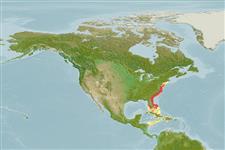>
Eupercaria/misc (Various families in series Eupercaria) >
Sciaenidae (Drums or croakers)
Etymology: Cynoscion: Greek, kyon = dog + Greek, odous = teeth + Greek, skion, skiaina = barbel, red mullet (Ref. 45335).
More on author: Cuvier.
Environment: milieu / climate zone / depth range / distribution range
Ecologie
marien; brak water demersaal; standvastig (Ref. 94474); diepte 10 - ? m (Ref. 9988). Subtropical; 42°N - 15°N, 83°W - 70°W (Ref. 94474)
Western Atlantic: New York to southern Florida in USA and the entire Gulf of Mexico. Northeastern Atlantic: recently reported from Guadalquivir River estuary in Spain (Ref. 94474).
Lengte bij maturiteit / Grootte / Gewicht / Leeftijd
Maturity: Lm 26.8, range 25 - 35 cm
Max length : 100.0 cm TL mannelijk / geslacht onbekend; (Ref. 40637); common length : 36.0 cm TL mannelijk / geslacht onbekend; (Ref. 3702); max. gepubliceerd gewicht: 7.9 kg (Ref. 40637); max. gerapporteerde leeftijd: 18 Jaren (Ref. 12193)
Dorsale stekels (totaal) : 9 - 11; Dorsale zachte stralen (totaal) : 25 - 28; Anale stekels: 2; Anale zachte stralen: 10 - 11. Body silvery, dark grey on back with bluish reflections and numerous round black spots irregularly scattered on upper half, extending to dorsal and caudal fin. Spinous dorsal fin dusky, other fins pale to yellowish. Mouth large, oblique lower jaw projecting. Upper jaw with a pair of large canine-like teeth at tip. Lower jaw with an enlarged inner row of teeth, uniform in size and closely set. Chin without barbels or pores. Snout with 2 marginal pores. Gas bladder with a pair of nearly straight horn-like appendages. Soft portion of dorsal fin unscaled (Ref 51721).
Inhabits river estuaries and shallow coastal marine waters over sand bottoms, often associated with seagrass beds. Also occurs in salt marshes and tidal pools of high salinity. Feeds mainly on crustaceans and fishes. An important food and sport fish throughout its range. Utilized fresh for steaming, broiling and baking (Ref. 9988).
Robins, C.R. and G.C. Ray, 1986. A field guide to Atlantic coast fishes of North America. Houghton Mifflin Company, Boston, U.S.A. 354 p. (Ref. 7251)
Status op de Rode Lijst van het IUCN (Ref. 130435: Version 2024-1)
Gevaar voor de mens
Harmless
Gebruik door de mens
Visserij: commercieel; sportvis: ja
Tools
Speciale rapporten
Download XML
Internetbronnen
Estimates based on models
Preferred temperature (Ref.
123201): 12 - 26.7, mean 24.3 °C (based on 88 cells).
Fylogenetische diversiteitsindex (Ref.
82804): PD
50 = 0.5000 [Uniqueness, from 0.5 = low to 2.0 = high].
Bayesian length-weight: a=0.00813 (0.00499 - 0.01323), b=3.05 (2.92 - 3.18), in cm total length, based on LWR estimates for this species & Genus-body shape (Ref.
93245).
Trofisch niveau (Ref.
69278): 4.0 ±0.66 se; based on food items.
Generation time: 5.8 (4.0 - 6.7) years. Estimated as median ln(3)/K based on 13
growth studies.
Weerstandsvermogen (Ref.
120179): Gemiddeld, minimale populatieverdubbelingstijd 1,4-4,4 jaar (K=0.2-0.3; tmax=18; tm=1; Fec=1 million).
Prior r = 0.69, 95% CL = 0.46 - 1.04, Based on 1 data-limited stock assessment.
Fishing Vulnerability (Ref.
59153): High vulnerability (58 of 100).
Climate Vulnerability (Ref.
125649): High vulnerability (60 of 100).
Nutrients (Ref.
124155): Calcium = 43.1 [25.3, 82.0] mg/100g; Iron = 0.771 [0.408, 1.320] mg/100g; Protein = 19.1 [17.7, 20.8] %; Omega3 = 0.33 [0.20, 0.51] g/100g; Selenium = 30.9 [16.5, 56.8] μg/100g; VitaminA = 9.52 [3.34, 29.64] μg/100g; Zinc = 0.667 [0.495, 0.966] mg/100g (wet weight);
